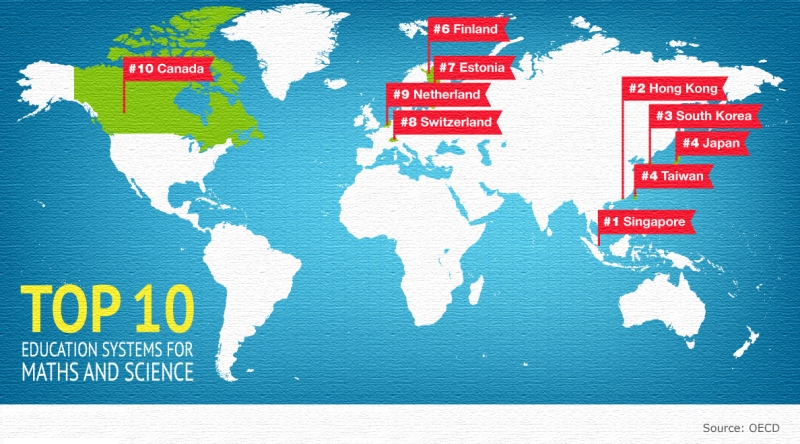About Singapore Math

Singapore Math has raised many other countries’ attention especially when the republic (Singapore) has emerged top in mathematics and science scores completed among 76 countries. It is touted as the “most comprehensive picture possible” of countries’ current skill levels.
Singapore was placed ahead of all nations including Hong Kong and South Korea, which ranked second and third place, respectively.
 Overall rankings based on maths and science, at age 15
Overall rankings based on maths and science, at age 15
- Singapore
- Hong Kong
- South Korea
- Japan (joint)
- Taiwan (joint)
- Finland
- Estonia
- Switzerland
- Netherlands
- Canada
So what is Singapore Math? What so special about it? In Singapore, it is simply refer as math program. It is developed under the supervision of Minister of Education of Singapore and introduced in since 1982 as Primary Mathematics Series. It focus on problem solving and heuristic model drawing. So what is really different is that it engage pupils in hand-on learning experiences and further enhance by pictorial representation which aids in forming a mental image of mathematical logical concept. Whereas other method emphasis on memorize the formulae and rule, Singapore Math focus on student’s understanding the fundamental concept.
One of the key component of Singapore math is to make the learning of math fun and meaningful so as to stir their interest towards math.
Currently, there are many countries have adopted Singapore Math for example in United States, Canada, Israel and United Kingdom. In United States, the early adopters or using Singapore Math textbooks were parents interested in homeschooling. There were limited schools (mostly private) adopted Singapore Math. Singapore Math popularity abruptly raised after the release of scores from the Trends in International Mathematics and Science Study (TIMSS), which showed Singapore as one of the top of the world (both in Math and Science). Many public and private schools in United States gradually adopting Singapore Math as their curriculum.
With so much attention gain on the Singapore math approach, United States educational publisher Houghton-Mifflin Harcourt has partnered with a Singapore leading educational publisher to publish and distribute a math series called Math In Focus: The Singapore Approach. In the New York Times reported in 2010, there are more than 1500 schools adopted Singapore Math approach.
It’s not the content that makes Singapore Math distinct than others, but rather it’s how it should be taught. Singapore Math focuses on building fundamental math skills based on the understanding that without a strong foundational base, students won’t be able to have anything to draw on when it comes to increasingly complicated math learning.
When comparing to the U.S. math curriculum, Singapore Math instead focus on fewer subjects or topics but have bigger coverage in detail. It emphasis on the student understanding the fundamental concept before moving on to the next stage hence student need not to re-learn those skill at the next level.
In Singapore math, it teaches students on a three-step process: concrete, pictorial and abstract. The learning process in fact is based on the work of an U.S psychologist, Jerome Bruner. Bruner believe that people learn in 3 states by first handling the real objects, then transitioning to images and finally to symbols. The Education ministry adapted this approach in early 1980s and build these concept to their math curriculum (which is now known as Singapore Math).
If you have observed the method, you would find most of the time it is using bar modeling. It is a pictorial method to resolve word problems in arithmetic. These bar models can come in multiple forms such as a whole-part or comparison model.
For more information on the methodologies of Singapore math, please refer to “model approach” at the left panel.
|
|
 |
Math Worksheets Generator
|
|
 |
Addition (2 Digits) |
|
 |
Addition (2 Digits)
No Regrouping |
|
 |
Addition (2 Digits)
With Regrouping On Ones |
|
 |
Addition (2 Digits)
With Regrouping On Ones & Tenths |
|
 |
Addition (3 Digits) |
|
 |
Subtraction (2 Digits) |
|
 |
Subtraction (2 Digits)
No Regrouping |
|
 |
Subtraction (2 Digits)
With Regrouping |
|
 |
Subtraction (3 Digits) |
|
 |
Multiplication (1 Digit) |
|
 |
Multiplication (2 Digits) |
Follow Us To Get Latest Updates
|
|

|
 |
We would love to hear your feedback on how we can improve our site to serve you better.
|
|
|
|
�����������������������������������������������������������������������������������������������������������������������������������������������������������������������������������������������������������������������������������������������������������������������������������������������������������������������������������
|